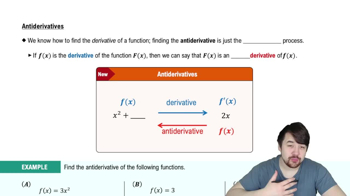Describe the set of antiderivatives of ƒ(x) = 1
Table of contents
- 0. Functions7h 54m
- Introduction to Functions16m
- Piecewise Functions10m
- Properties of Functions9m
- Common Functions1h 8m
- Transformations5m
- Combining Functions27m
- Exponent rules32m
- Exponential Functions28m
- Logarithmic Functions24m
- Properties of Logarithms36m
- Exponential & Logarithmic Equations35m
- Introduction to Trigonometric Functions38m
- Graphs of Trigonometric Functions44m
- Trigonometric Identities47m
- Inverse Trigonometric Functions48m
- 1. Limits and Continuity2h 2m
- 2. Intro to Derivatives1h 33m
- 3. Techniques of Differentiation3h 18m
- 4. Applications of Derivatives2h 38m
- 5. Graphical Applications of Derivatives6h 2m
- 6. Derivatives of Inverse, Exponential, & Logarithmic Functions2h 37m
- 7. Antiderivatives & Indefinite Integrals1h 26m
- 8. Definite Integrals4h 44m
- 9. Graphical Applications of Integrals2h 27m
- 10. Physics Applications of Integrals 3h 16m
- 11. Integrals of Inverse, Exponential, & Logarithmic Functions2h 34m
- 12. Techniques of Integration7h 41m
- 13. Intro to Differential Equations2h 55m
- 14. Sequences & Series5h 36m
- 15. Power Series2h 19m
- 16. Parametric Equations & Polar Coordinates7h 58m
7. Antiderivatives & Indefinite Integrals
Antiderivatives
Problem 4.9.15
Textbook Question
Finding antiderivatives. Find all the antiderivatives of the following functions. Check your work by taking derivatives.
p(x) = 3 sec² x
 Verified step by step guidance
Verified step by step guidance1
Step 1: Recall the definition of an antiderivative. The antiderivative of a function is a function whose derivative is the original function. For this problem, we need to find the antiderivative of p(x) = 3 sec²(x).
Step 2: Identify the basic antiderivative rule that applies here. The derivative of tan(x) is sec²(x), so the antiderivative of sec²(x) is tan(x). Use this rule to find the antiderivative of 3 sec²(x).
Step 3: Multiply the constant 3 by the antiderivative of sec²(x). This gives us 3 tan(x) as part of the solution.
Step 4: Add the constant of integration, C, to account for all possible antiderivatives. The general antiderivative of p(x) = 3 sec²(x) is therefore 3 tan(x) + C.
Step 5: Verify your work by taking the derivative of the antiderivative you found. Differentiate 3 tan(x) + C, and confirm that the result is 3 sec²(x), which matches the original function.
 Verified video answer for a similar problem:
Verified video answer for a similar problem:This video solution was recommended by our tutors as helpful for the problem above
Video duration:
2mPlay a video:
Was this helpful?
Key Concepts
Here are the essential concepts you must grasp in order to answer the question correctly.
Antiderivatives
An antiderivative of a function is another function whose derivative is the original function. In calculus, finding antiderivatives is essential for solving problems related to integration. The process involves determining a function F(x) such that F'(x) equals the given function p(x). Antiderivatives are not unique; they can differ by a constant, represented as F(x) + C, where C is any constant.
Recommended video:

Antiderivatives
Integration
Integration is the process of finding the integral of a function, which is closely related to finding antiderivatives. It can be thought of as the reverse operation of differentiation. The integral of a function over an interval gives the area under the curve of that function. In this context, the integral of p(x) = 3 sec² x will yield the family of functions that are antiderivatives of p(x).
Recommended video:

Integration by Parts for Definite Integrals
Derivative Check
To verify that a function is indeed an antiderivative, one can take its derivative and check if it matches the original function. This process is crucial in confirming the correctness of the antiderivative found. For example, if F(x) is an antiderivative of p(x), then differentiating F(x) should yield p(x). This step ensures that the integration process was performed correctly.
Recommended video:

Derivatives
Related Videos
Related Practice
Textbook Question
30
views


